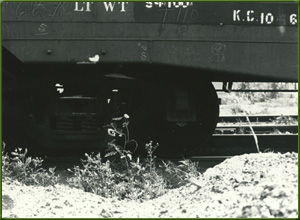
Seed spillage, probably 1969. Missouri Botanical Garden collections. Click on image to enlarge. (224 KB)
 |
PANEL 1 |  |
|
Railroad botany was an established field in Europe when Victor Muehlenbach (1899-1986) came to the U.S. from Riga, Latvia, in 1944, escaping the war-torn continent. Muehlenback retired from mycological work in 1968 at the age of 70, then got serious about moving his botanical project toward publication. In 1979 he published his major work, "Contributions to the Synanthropic (Adventive) Flora of the Railroads in St. Louis." In the U.S., his work is considered a pioneering effort in the study of adventive plants. Seeds are found in the lubrication fluid of the train cars' wheel assemblies, in spillage from cars, even in railroad men's shoes. Muehlenbach claimed in a 1978 interview that he "began to notice that the plants I found on the railroads were beginning to show up on my lawn. I had the idea to examine the cuffs of my trousers and shoes seeds! So some of the plants even a rrive this way." Muehlenbach worked for more than 30 years on railroad botany and showed that many plants, such as Carduus nutans, or nodding thistle, were adventive introductions to the area. Muehlenbach reported in 1981 to have seen on the tracks Japanese honeysuckle, creeping bellflower, dill, sesame, apple and peach trees, larkspur, petunias, and lots of weeds! |
 |
|||
|
Seed spillage, probably 1969. Missouri Botanical Garden collections. Click on image to enlarge. (224 KB) |
|||
|
 Railroads Panels: 1
| 2 | 3 | 4
| 5 | 6 | 7
| Exhibit Home
Railroads Panels: 1
| 2 | 3 | 4
| 5 | 6 | 7
| Exhibit Home 